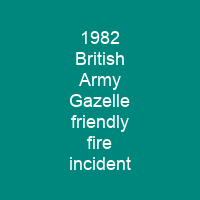June 6, 1982: The Tragic Friendly Fire Incident
Imagine a night so clear that even the stars seemed to pause in their dance, and amidst this serene sky, tragedy unfolded. On June 6, 1982, during the Falklands War, HMS Cardiff, a British warship, mistakenly shot down its own helicopter, killing all four crew members. This incident was not just a moment of sorrow but a stark reminder of the complexities in warfare and the importance of clear communication.
The Night Mission
That night, the Gazelle helicopter, serial number XX377, took off from Goose Green. Its mission was to collect replacement equipment and two passengers. Little did anyone know that this seemingly routine operation would end in disaster.
The Mistaken Identity
Can you imagine the confusion as the Gazelle approached HMS Cardiff? The destroyer, on high alert for enemy aircraft, detected the helicopter on its radar. Due to poor communication and the helicopter’s IFF (Identification Friend or Foe) system being turned off, it was mistakenly identified as an Argentine Lockheed C-130 Hercules.
The Tragic Decision
Cardiff fired two Sea Dart missiles, but only one exploded, causing the Gazelle to crash. The British government suspected Argentine forces were still operating in the area and mounted patrols. A proper search was carried out at first light, finding the wreckage and dead aircrew and passengers.
The Aftermath: An Official Inquiry
How could such a tragic mistake happen? The incident led to an official board of inquiry four years later in October 1986. The findings revealed that poor communication between the army and navy, lack of IFF transmission from the helicopter, and Cardiff’s position change without notifying land forces were key factors.
The Recommendations
The board recommended amendments to NATO procedures for amphibious warfare and naval gunfire support. Measures were taken to address the problem, including fitting IFF transmitters to all relevant helicopters and broadening the responsibilities of naval gunfire-support liaison officers.
A Memorial to Remember
On Pleasant Peak, a memorial cross was installed to commemorate the incident. It stands as a silent reminder of the human cost of war and the importance of clear communication in military operations.

The Gazelle helicopter’s tragic fate serves as a poignant reminder of the complexities and dangers in modern warfare. It underscores the critical need for clear communication, technology, and human vigilance to prevent such tragedies from recurring.
In the end, it is our duty to remember these incidents not just as historical events but as lessons that can guide us towards safer and more effective military operations in the future.
You want to know more about 1982 British Army Gazelle friendly fire incident?
This page is based on the article 1982 British Army Gazelle friendly fire incident published in Wikipedia (retrieved on November 28, 2024) and was automatically summarized using artificial intelligence.







